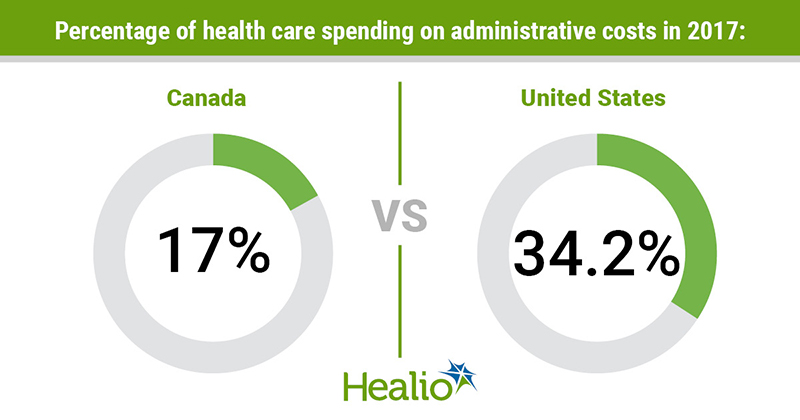A Third of U.S. Health Care Spending Stems from Administrative Costs

In 2017, administrative costs accounted for 34.2% of all health care expenditures in the United States, twice the percentage spent on administration in Canada, according to study findings published in the Annals of Internal Medicine.
“Much of the money that patients, employers and the government in the U.S. are spending for health care is wasted on bureaucracy that adds no value,” David U. Himmelstein, MD, professor at the City University of New York School of Public Health at Hunter College, told Healio Primary Care. “This waste drains resources from care, drives up prices, and frustrates doctors and patients.”
Canada, which switched to a single-payer health care system in the 1960s, originally had payment systems, health costs and numbers of administrative personnel similar to the U.S., according to the researchers. In 1999, data showed that 31% of U.S. health care expenditures stemmed from administrative costs, compared with 16.7% in Canada.
To evaluate administrative costs to insurers and providers in 2017, Himmelstein and colleagues analyzed government reports, accounting data, physician surveys and census data on health care-based employment from the U.S. and Canada.

Researchers assessed insurance overhead along with administrative spending in hospitals, physician practices, nursing homes, home care agencies and hospices.
In 2017, $812 billion — $2,497 per capita — was spent on health care administrative costs in the U.S., representing 34.2% of national health care expenditures. In comparison, 17% of Canada’s total health care spending was attributed to administration, or approximately $551 per capita.
Insurer’s overhead was considerably higher in the U.S. at $844 per capita, compared with $146 per capita in Canada.
Compared with Canada, U.S. spending was greater for hospital administration ($933 vs. $196), nursing home, home care and hospice administration ($255 vs. $123), and physicians’ insurance-related costs ($465 vs. $87).
Researchers found that 2.4 of the 3.2-percentage point increase in U.S. spending on administration was caused by growth in private insurer’s overhead, mostly due their expanded role administrating Medicare and Medicaid plans.
“It's ultimately patients who pay for the sky-high administrative costs, making care less affordable and driving up medical debts,” Himmelstein told Healio Primary Care.
“Single payer reform — so-called Medicare for All — is the only proven way to streamline administration and drive down bureaucratic costs,” he continued. “As long as private insurers remain in the middle of our health care system, they'll continue to exact a heavy toll of administrative waste.” – by Erin Michael
Disclosures: Himmelstein reports no relevant financial disclosures. Please see study for all other authors’ relevant financial disclosures.
See the original article HERE



Comments
There are 0 comments for this article